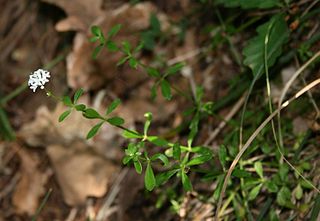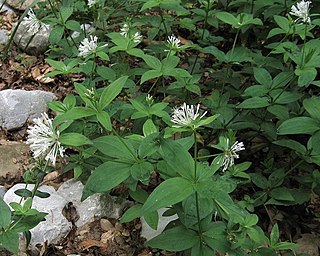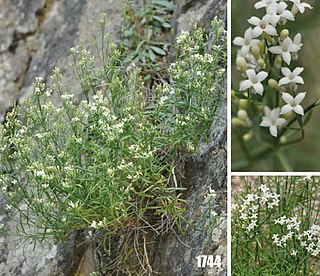
Asperula, commonly known as woodruff, is a genus of flowering plants in the family Rubiaceae. It contains 91 species and has a wide distribution area from Europe, northern Africa, temperate and subtropical Asia to Australasia.
Asperula crassula is a species of flowering plant in the family Rubiaceae, endemic to a few hundred hectares in northeast Crete. It was first described in 1857.

Asperula involucrata is a species of flowering plant in the family Rubiaceae.
Asperula podlechii is a species of flowering plant in the family Rubiaceae. It was first described in 2005 and is endemic to Afghanistan.
Asperula scoparia is a species of flowering plant in the family Rubiaceae. It was first described in 1847 and is endemic to Tasmania, Victoria and New South Wales in Australia.
Asperula serotina is a species of flowering plant in the family Rubiaceae. It was first described in 1982 and is endemic to Turkey.

Asperula taurina is a species of flowering plant in the family Rubiaceae. It was first described in 1753 and is endemic to Albania, Austria, Bulgaria, France, Greece, Hungary, Iran, Italy, Crimea, Romania, Switzerland, Georgia, Armenia, Azerbaijan, Turkey, Slovenia, Croatia, Bosnia, Serbia, and Montenegro. It was also introduced to Denmark, Germany, and Great Britain.
Asperula taygetea is a species of flowering plant in the family Rubiaceae. Asperula taygetea was first described in 1849 and is endemic to Greece.
Asperula subulifolia is a species of flowering plant in the family Rubiaceae. It was first described in 1928 and is endemic to Australia.
Asperula tetraphylla is a species of flowering plant in the family Rubiaceae. It was first described in 2009 and is endemic to South Australia.
Asperula wimmeriana is a species of flowering plant in the family Rubiaceae. It was first described in 1928 and is endemic to south east Australia.
Asperula xylorrhiza is a species of flowering plant in the family Rubiaceae. It is endemic to Turkey and Iraq.
Asperula acuminata is a deciduous species of perennial groundcover, and a flowering plant in the family Rubiaceae, known as Woodruff, and is endemic to NE. New South Wales of Australia, and was first named by I.Thomps.

Asperula albiflora is a deciduous species of perennial groundcover, and a flowering plant in the family Rubiaceae, known as Woodruff, and is endemic to Turkmenistan, and was first named by Popov.
Asperula ambleia is a deciduous species of perennial groundcover, and a flowering plant in the family Rubiaceae, known as Stiff Woodruff, and is endemic from SE. Queensland to NE. Victoria in Australia, and was first named by Airy Shaw.
Asperula assamica is a deciduous species of perennial groundcover, and a flowering plant in the family Rubiaceae, known as Woodruff, and is endemic to Assam, East Himalayas, and was first named by Meisn.
Asperula asterocephala is a deciduous species of perennial groundcover, and a flowering plant in the family Rubiaceae, known as Woodruff, and is endemic to Iraq, and was first named by Bornm.




